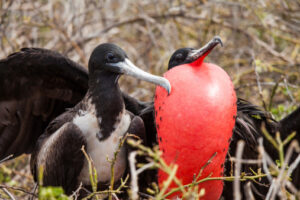Magnificent, Great, Ascension, Christmas, and Lesser frigatebirds are the five types found in the world. Due to their enormous wingspan, they can spend weeks soaring over the ocean searching for food. Two types of frigatebirds are found in the Americas’ tropical regions; the Magnificent and the Great. If you’ve ever seen one in the sky, you might have wondered, “how big is a frigatebird?” Do you want to know? Keep reading.
The magnificent frigatebird has the highest wingspan-to-body size ratio of any bird and is the largest of the five frigatebird species. Their massive wingspan of up to 2.4 m (7 ft 10 in) allows them to glide effortlessly over the ocean in search of prey below.
All frigatebird species, with the exception of the much smaller Lesser frigatebird, can have wingspans greater than 2 metres (6 ft 7 in). At the very least, this can be twice as long as its body. Because of their massive size, they can intimidate smaller hunting birds into stealing the fish and squid they have caught in the ocean for themselves, a behaviour known as kleptoparasitism. Because of this, they are also known as “pirates of the sea” or “man o’ war” birds.
Weight of Frigatebirds
Females of all five species of frigatebirds are up to 25 percent larger and heavier than males. In all cases, males are lighter than the highest reported female weight. The following are the typical weight ranges for each of the five species:
- Christmas Island frigatebird: 1,400 to 1550g (3.1 to 3.4 lb)
- Magnificent frigatebird: 1,000 to 1,900 g (2.2 to 4.2 lb)
- Ascension frigatebird: 1,200 g (2.6 lb)
- Lesser frigatebird: 625 to 955g (1.4 to 2.1 lb)
- Great frigatebird: 1,000 to 1,640g (2.2 to 3.6 lb)
Wingspans Frigatebird
The enormous wing area of all five species of frigatebirds allows them to effortlessly glide for great distances over the ocean. When compared to its body size, the Magnificent frigatebird’s wingspan is the biggest of any bird. Below, you’ll find a list of the species’ typical wing span ranges.
- Ascension frigatebird (Fregata aquila): 196 to 201 cm (6 ft 5 into 6 ft 7 in)
- Lesser frigatebird (Fregata ariel): 155 to 193 cm (5 ft 1 into 6 ft 4 in)
- Great frigatebird (Fregata minor): 205 to 230 cm (6 ft 9 into 7 ft 7 in)
- Magnificent frigatebird (Fregata magnificens): 217 to 244 cm (7 ft 1 into 8 ft)
- Christmas Island frigatebird (Fregata andrewsi): 205 to 230 cm (6 ft 9 into 7 ft 7 in)
How big an animal can a frigatebird can catch?
Frigatebirds cannot catch prey with their feet because they have webbed feet instead of sharp, grasping claws. Only huge fish, squid, jellyfish, and small seabird chicks are suitable for transport in their beaks.
Famous for its kleptoparasitism, frigatebirds annoy other birds in the sky until they drop their catch, which the frigatebird then picks up from the water’s surface.
How big is the Frigatebird?
The Magnificent frigatebird, with its greatest reported wing span of 244 cm or 8ft, is the largest frigatebird species. Even the smallest frigatebird, the Lesser frigatebird, has a maximum wing span greater than a human being’s height. The longest Magnificent frigatebird may have a wingspan of up to 244 centimetres, making even the tallest human far shorter (8ft). A person dwarfs a frigatebird in every way except size; even the largest specimens are only a few inches tall at the shoulder and weigh less than 2 kilograms.
Body length of Frigatebird
Each species of frigatebird has a relatively low body length compared to its enormous wing span. The following tables show the typical sizes of these animals:
- Ascension frigatebird: 89 to 96 cm (2 ft 11 into 3 ft 2 in)
- Lesser frigatebird: 66 to 81 cm (2 ft 2 into 2 ft 8 in)
- Christmas Island frigatebird: 89 to 100cm (2 ft 9 into 3 ft 3 in)
- Magnificent frigatebird: 89 to 144 cm (2 ft 11 into 4 ft 9 in)
- Great frigatebird: 85 to 105 cm (2 ft 9 into 3 ft 5 in)
- Is it possible for a Frigatebird to pick up a human?
No instances of frigatebirds taking up humans have ever been documented, and the bird’s weaker body mass makes it difficult for it to raise even a light toddler. We need not fear getting kidnapped by a frigatebird because they avoid humans and would much rather soar over the water than on land.
Read Also
Do Starlings Migrate? Everything You Need to Know



